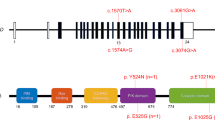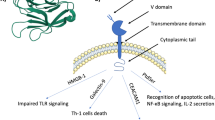Abstract
Background
T cell immunodeficiency is a common feature in cancer patients, which may relate to initiation and development of tumor. Our previous study showed skewed expression of T cell receptor beta variable region (TRBV) subfamilies and clonal expansion of T cells in leukemia patients. In the present study, in order to further characterize the T cell immunity in acute myeloid leukemia (AML) patients, the level of recent thymic emigrants (RTE) was analyzed.
Materials and methods
Quantitative analysis of signal joint T cell recombination excision circles (δRec-ψJα sjTRECs) was performed in peripheral blood mononuclear cells (PBMCs) by real-time PCR (TaqMan), and the analysis of 23 TRBV-BD1 sjTRECs was performed by semi-nested PCR. Eighty-eight cases with AML were selected for this study; ten AML cases in complete remission (AML-CR) and 38 healthy individuals served as controls.
Results
The levels of δRec-ψJα sjTRECs in PBMCs and CD3+ T cells were significantly decreased in AML patients, compared with healthy individuals and in patients in completive remission. Also the frequency of 23 TRBV-BD1 sjTRECs, and the number of detectable TRBV subfamily sjTRECs were significantly lower in AML patients than in healthy individuals. Moreover, the sjTRECs numbers and the frequency of TRBV-BD1 sjTRECs showed a progressive linear decline with age in AML patients.
Conclusions
The decreased numbers of universal (δRec-ψJα) and family-specific (TRBV-BD1) sjTRECs indicate that the severe T cell immunodeficiency in AML patients is associated with reduced levels of recent thymic emigrants. In patients achieving complete remission both sjTREC counts return to normal values indicating the recovery of thymic function. Better understanding of the mechanisms underlying persistent immunodeficiency in leukemia patients may lead to novel treatment strategies to enhance immune competence.








Similar content being viewed by others
References
Deschler B, Lübbert M (2006) Acute myeloid leukemia: epidemiology and etiology. Cancer 107:2099–2107
Erba HP (2007) Prognostic factor in elderly patients with AML and the implications for treatment. Hematology Am Soc Hematol Educ Program 2007:420–428
Hadden JW (2003) Immunodeficiency and cancer: prospects for correction. Int Immunopharmacol 3:1061–1071
Costello RT, Rey J, Fauriat C, Gastaut JA, Olive D (2003) New approaches in the immunotherapy of haematological malignancies. Eur J Haematol 70:333–345
Li Y, Chen S, Yang L, Zhou Y, Wu X, Huang M, Geng S (2005) Clonal expanded TCR Vβ T cells in patients with APL. Hematology 10:135–139
Li Y (2005) Recent thymic output function in patients with hematological malignancy. Hematology 10:297–305
De Villartay JP, Hockett R, Coran D, Korsmeyer SJ, Cohen DI (1998) Deletion of the human T-cell receptor δ-gene by a site specific recombination. Nature 335:170–174
Douek DC, McFarland RD, Keiser PH, Gage EA, Massey JM, Haynes BF, Polis MA, Haase AT, Feinberg MB, Sullivan JL, Jamieson BD, Zack JA, Picker LJ, Koup RA (1998) Changes in thymic function with age and during the treatment of HIV infection. Nature 396:690–695
Hazenberg MD, Verschuren MC, Hamann D, Miedema F, van Dongen JJ (2001) T cell receptor excision circles as markers for recent thymic emigrants: basic aspects, technical approach, and guidelines for interpretation. J Mol Med 79:631–640
Geenen V, Poulin JF, Dion ML, Martens H, Castermans E, Hansenne I, Moutschen M, Sekaly RP, Cheynier R (2003) Quantification of T cell receptor rearrangement excision circles to estimate thymic function: an important new tool for endocrine-immune physiology. J Endocrinol 176:305–311
Al-Harthi L, Marchett G, Steffens CM, Poulin J, Sekaly R, Landay A (2000) Detection of T cell receptor circles (TRECs) as biomarkers for de novo T cell synthesis using a quantitative polymerase chain reaction-enzyme linked immunosorbent assay (PCR-ELISA). J Immunol Methods 237:187–197
Poulin JF, Viswanathan MN, Harris JM, Komanduri KV, Wieder E, Ringuette N, Jenkins M, McCune JM, Sékaly RP (1999) Direct evidence for thymic function in adult humans. J Exp Med 190:479–486
Poulin JF, Sylvestre M, Champagne P, Dion ML, Kettaf N, Dumont A, Lainesse M, Fontaine P, Roy DC, Perreault C, Sékaly RP, Cheynier R (2003) Evidence for adequate thymic function but impaired naive T-cell survival following allogeneic hematopoietic stem cell transplantation in the absence of chronic graft-versus-host disease. Blood 102:4600–4607
Petridou E, Klimentopoulou AE, Moustaki M, Kostrikis LG, Hatzakis A, Trichopoulos D (2002) Recent thymic emigrants and prognosis in T- and B-cell childhood hematopoietic malignancies. Int J Cancer 101:74–77
Haining WN, Evans J, Seth N, Callaway G, Wucherpfennig K, Nadler L, Guinan E (2004) Rapid T cell response to vaccination can occur without antibody response in children post HSCT. Blood 104(11):614a
Li Y, Yang L, Chen S, Wang Z, Wu X, Przybylski GK, Schmidt CA (2003) Recent thymic output function in patients with acute myelogenous leukemia. Blood 102(11):608a
Kimmig S, Przybylski GK, Schmidt CA, Laurisch K, Mowes B, Radbruch A, Thiel A (2002) Two subsets of naive T helper cells with distinct T cell receptor excision circle content in human adult peripheral blood. J Exp Med 195:789–794
Li Y, Chen S, Yang L, Yin Q, Geng S, Wu X, Schmidt CA, Przybylski GK (2007) TRAV and TRBV repertoire, clonality and the proliferative history of umbilical cord blood T cells. Transplant Immunol 18:151–158
Li Y (2003) Leukemia associated clonal expansion TCR Vβ subfamily T cells. Hematology 8:375–384
Farace F, Orlanducci F, Dietrich PY, Gaudin C, Angevin E, Courtier MH, Bayle C, Hercend T, Triebel F (1994) T cell repertoire in patients with B chronic lymphocytic leukemia evidence for multiple in vivo T cell clonal expansions. J Immunol 153:4281–4290
Alatrakchi N, Farace F, Frau E, Carde P, Munck JN, Triebel F (1998) T-cell clonal expansion in patients with B-cell lymphoproliferative disorders. J Immunother 21:363–370
Serrano D, Monteiro J, Allen SL, Kolitz J, Schulman P, Lichtman SM, Buchbinder A, Vinciguerra VP, Chiorazzi N, Gregersen PK (1997) Clonal expansion within the CD4+CD57+ and CD8+CD57+T cell subsets in chronic lymphocytic leukemia. J Immunol 158:1482–1489
Hazenberg MD, Borghans JAM, de Boer RJ, Miedema F (2003) Thynic output: a bad TREC record. Nat Immunol 4:97–99
Yin QS, Li YQ, Chen SH, Yang LJ, Lu YH, Zhang XL (2006) Detection of TCR Vbeta subfamily sjTRECs in normal peripheral blood and cord blood. Xi Bao Yu Fen Zi Mian Yi Xue Za Zhi (J Cell Mol Immunol) 22:477–479
Pido-Lopez J, Imami N, Aspinall R (2001) Both age and gender affect thymic output: more recent thymic migrants in females than males as they age. Clin Exp Immunol 125:409–413
Acknowledgments
This project was sponsored by grants from National Natural Science Foundation of China (No. 30270579), Natural Science Foundation of Guangdong Province (No.23001) and the Department of Education of Guangdong Province (No. Q 02022). We thank Prof. Xin Du from Dept. of Hematology, Guangdong Provincial People’s Hospital for kindly providing AML samples.
Author information
Authors and Affiliations
Corresponding authors
Rights and permissions
About this article
Cite this article
Li, Y., Yin, Q., Yang, L. et al. Reduced levels of recent thymic emigrants in acute myeloid leukemia patients. Cancer Immunol Immunother 58, 1047–1055 (2009). https://doi.org/10.1007/s00262-008-0621-3
Received:
Accepted:
Published:
Issue Date:
DOI: https://doi.org/10.1007/s00262-008-0621-3




